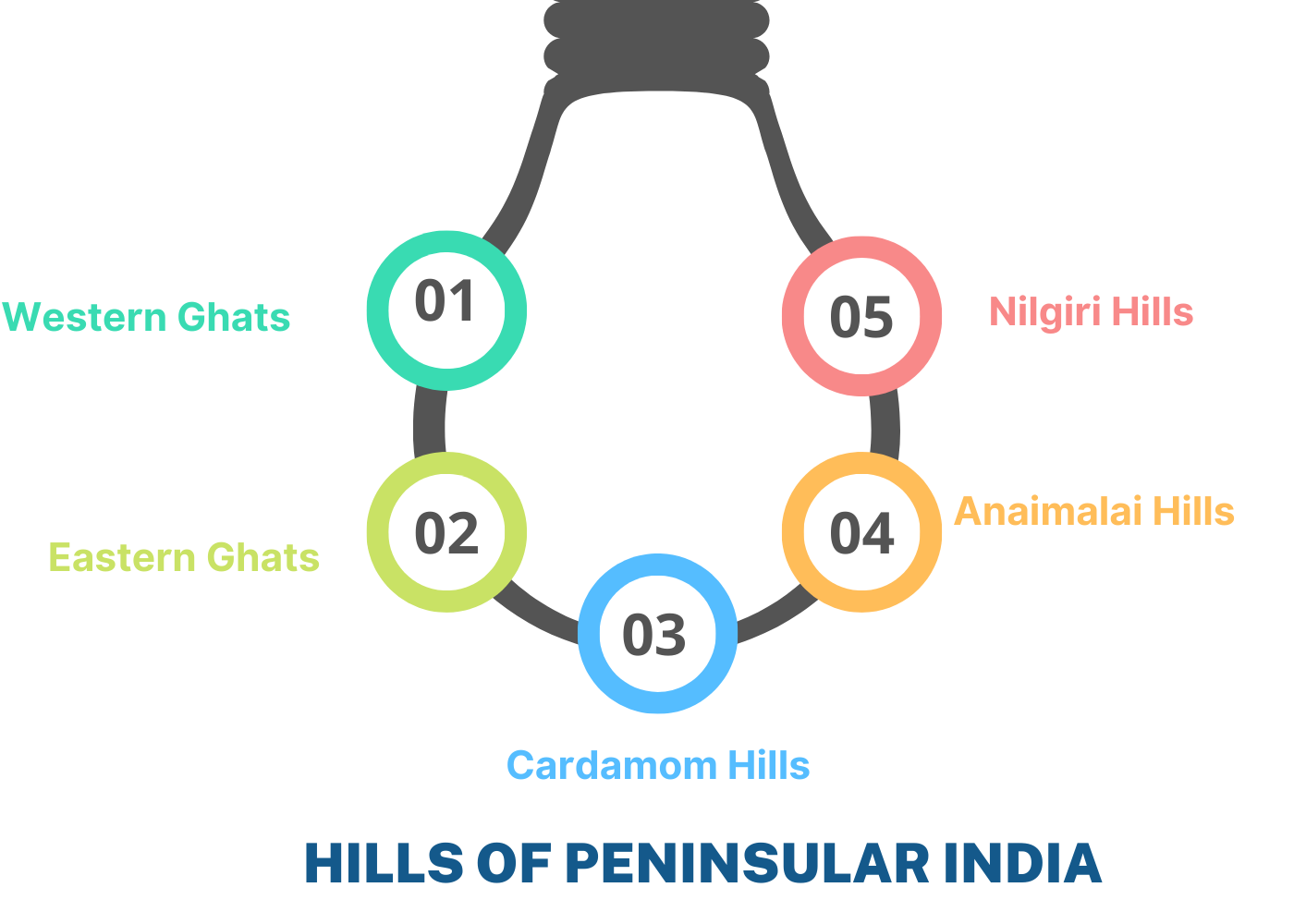Detailed content
Introduction to Peninsular India's Hills
• Peninsular India, also known as the Deccan Plateau, is characterized by a vast expanse of upland terrain with several hill ranges interspersed across its landscape. These hills are not only significant geographically but also culturally, ecologically, and economically.
Geological Formation
• The geological history of peninsular India is complex and spans millions of years. The hills of this region have been shaped by various geological processes such as tectonic movements, volcanic activity, and erosion. One of the most significant events in the formation of these hills was the break-up of the supercontinent Gondwana, which led to the separation of the Indian subcontinent from Africa and Madagascar around 90 million years ago
Major Hill Ranges
• Western Ghats: Running parallel to the western coast of India, the Western Ghats are one of the most prominent hill ranges in peninsular India. They extend from the Tapti River in the north to the southern tip of the subcontinent, covering a distance of over 1,600 kilometers. The Western Ghats are known for their rich biodiversity and are recognized as a UNESCO World Heritage Site.
• Eastern Ghats: Unlike the continuous and lofty Western Ghats, the Eastern Ghats are discontinuous and relatively lower in elevation. Stretching along the eastern coast of India, this range is older than its western counterpart and has been subjected to extensive erosion over time. Despite their lower elevation, the Eastern Ghats are also ecologically significant and home to diverse flora and fauna.
• Satpura Range: Situated in central India, the Satpura Range is known for its rugged terrain and dense forests. It serves as a natural barrier between northern and southern India and is an important watershed region. The Satpura Range is also home to several wildlife sanctuaries and national parks.
• Aravalli Range: Running across the western states of Rajasthan, Haryana, and Gujarat, the Aravalli Range is one of the oldest mountain ranges in India. While not as high or imposing as some of the other ranges, the Aravallis are culturally significant and have played a crucial role in the region's history and ecology.
Ecological Significance
• The hills of peninsular India support a wide variety of ecosystems, ranging from tropical rainforests to dry deciduous forests and grasslands. These ecosystems are home to numerous plant and animal species, many of which are endemic to the region. The Western Ghats, in particular, are considered a global biodiversity hotspot due to their high levels of species diversity and endemism.
Climate and Water Resources
• The hills of peninsular India play a crucial role in shaping the region's climate and water resources. They act as a barrier to the monsoon winds, leading to orographic rainfall along their windward slopes. This rainfall is vital for agriculture and provides water for drinking, irrigation, and hydroelectric power generation. The Western Ghats, in particular, are known for their role in capturing and storing moisture from the southwest monsoon, which is then released gradually, replenishing rivers and groundwater aquifers across the region
Economic Importance
• The hills of peninsular India are economically significant, supporting various industries such as agriculture, forestry, mining, and tourism. The fertile soils of these hills are conducive to agriculture, with crops such as tea, coffee, spices, and fruits being cultivated in the Western Ghats and other hill regions. Additionally, the hills are a source of valuable minerals such as iron ore, bauxite, and limestone, which are mined for industrial use. Tourism also contributes significantly to the economy of hill regions, with millions of visitors drawn to their natural beauty, wildlife, and cultural heritage each year.
Cultural Heritage
• The hills of peninsular India are steeped in cultural heritage, with indigenous communities and traditional societies inhabiting these regions for centuries. These communities have developed unique ways of life, adapted to the challenges and opportunities presented by the hilly terrain. The hills are also home to ancient temples, forts, and other historical sites, reflecting the rich cultural heritage of the region.
• In conclusion, the hills of peninsular India are not just geological features but dynamic landscapes that shape the region's ecology, climate, economy, and culture. Understanding and preserving these hills are essential for sustainable development and the well-being of both the environment and the people who depend on it.
